Alfonso XIII of Spain
Alfonso XIII (17 May 1886 – 28 February 1941), also known as El Africano or the African, was King of Spain from 1886 until the proclamation of the Second Republic in 1931. Alfonso was monarch from birth as his father, Alfonso XII, had died the previous year. Alfonso's mother, Maria Christina of Austria, served as regent until he assumed full powers on his sixteenth birthday in 1902.
| Alfonso XIII | |||||
|---|---|---|---|---|---|
 | |||||
| King of Spain (more...) | |||||
| Reign | 17 May 1886 – 14 April 1931 | ||||
| Enthronement | 17 May 1902 | ||||
| Predecessor | Alfonso XII | ||||
| Successor | Monarchy abolished (Niceto Alcalá-Zamora as President of the Second Spanish Republic) | ||||
| Regent | Maria Christina | ||||
| Prime ministers | Práxedes Mateo Sagasta
... among others
| ||||
| Born | 17 May 1886 Royal Palace of Madrid, Madrid, Kingdom of Spain | ||||
| Died | 28 February 1941 (aged 54) Rome, Kingdom of Italy | ||||
| Burial | |||||
| Spouse | Victoria Eugenie of Battenberg (m. 1906) | ||||
| Issue ... among others |
| ||||
| |||||
| House | Bourbon | ||||
| Father | Alfonso XII of Spain | ||||
| Mother | Maria Christina of Austria | ||||
| Religion | Roman Catholic | ||||
| Signature | |||||
During Alfonso's reign of the Kingdom of Spain, it experienced four major problems that contributed to the end of the liberal monarchy: the lack of real political representation of broad social groups; the poor situation of the popular classes, especially peasants; problems arising from the Rif War; and Catalan nationalism. The political and social turbulence that began with the Spanish–American War prevented the turnaround parties from establishing a true liberal democracy, which led to the establishment of the dictatorship of Miguel Primo de Rivera. With the political failure of the dictatorship, Alfonso impelled a return to the democratic normality with the intention of regenerating the regime. Nevertheless, it was abandoned by all political classes, as they felt betrayed by the king's support of the dictatorship of Primo de Rivera.
He left Spain voluntarily after the municipal elections of April 1931, which were taken as a plebiscite on abolishing the monarchy.
Reign
Birth and regency
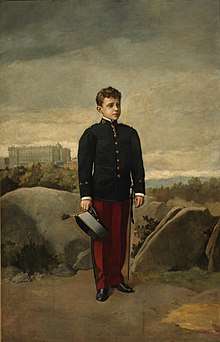
Alfonso was born at Royal Palace of Madrid in Madrid on 17 May 1886. He was the posthumous son of Alfonso XII of Spain, who had died in November 1885, and became King of Spain upon his birth. Just after he was born, he was carried naked to the Spanish prime minister on a silver tray.
Five days later he was carried in a solemn court procession with a golden fleece round his neck and was baptized with water specially brought from the River Jordan in Palestine.[1] The French newspaper Le Figaro described the young king in 1889 as "the happiest and best-loved of all the rulers of the earth".[2] His mother, Maria Christina of Austria, served as his regent until his 16th birthday. During the regency, in 1898, Spain lost its colonial rule over Cuba, Puerto Rico, Guam and the Philippines to the United States as a result of the Spanish–American War.
When he came of age in May 1902, the week of his majority was marked by festivities, bullfights, balls and receptions throughout Spain.[3] He took his oath to the constitution before members of the Cortes on 17 May.
Engagement and marriage

By 1905, Alfonso was looking for a suitable consort. On a state visit to the United Kingdom, he stayed at Buckingham Palace with King Edward VII. There he met Princess Victoria Eugenie of Battenberg, the daughter of Edward's youngest sister Princess Beatrice, and a granddaughter of Queen Victoria. He found her attractive, and she returned his interest. There were obstacles to the marriage. Victoria was a Protestant, and would have to become a Catholic. Victoria's brother Leopold was a haemophiliac, so there was a 50 percent chance that Victoria was a carrier of the trait. Finally, Alfonso's mother Maria Christina wanted him to marry a member of her family, the House of Habsburg-Lorraine, or some other Catholic princess, as she considered the Battenbergs to be non-dynastic.
Victoria was willing to change her religion, and her being a haemophilia carrier was only a possibility. Maria Christina was eventually persuaded to drop her opposition. In January 1906 she wrote an official letter to Princess Beatrice proposing the match. Victoria met Maria Christina and Alfonso in Biarritz, France, later that month, and converted to Catholicism in San Sebastián in March.
.jpg)
In May, diplomats of both kingdoms officially executed the agreement of marriage. Alfonso and Victoria were married at the Royal Monastery of San Jerónimo in Madrid on 31 May 1906, with British royalty in attendance, including Victoria's cousins the Prince and Princess of Wales (later King George V and Queen Mary). The wedding was marked by an assassination attempt on Alfonso and Victoria by Catalan anarchist Mateu Morral. As the wedding procession returned to the palace, he threw a bomb from a window which killed or injured many bystanders and members of the procession.[4]
On 10 May 1907, the couple's first child, Alfonso, Prince of Asturias, was born. However, Victoria was in fact a haemophilia carrier, and Alfonso inherited the condition.
Neither of the two daughters born to the King and Queen were haemophilia carriers, but another of their sons, Gonzalo (1914–1934), had the condition. Alfonso distanced himself from his wife for transmitting the condition to their sons.[5]
From 1914 on, he had several mistresses, and fathered five illegitimate children. A sixth illegitimate child had been born before his marriage.
World War I
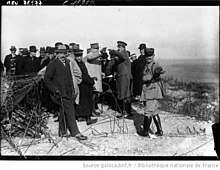
During World War I, because of his family connections with both sides and the division of popular opinion, Spain remained neutral.[6] The King established an office for assistance to prisoners of war on all sides. This office used the Spanish diplomatic and military network abroad to intercede for thousands of POWs – transmitting and receiving letters for them, and other services.[7] The office was located in the Royal Palace.
Alfonso became gravely ill during the 1918 flu pandemic. Spain was neutral and thus under no wartime censorship restrictions, so his illness and subsequent recovery were reported to the world, while flu outbreaks in the belligerent countries were concealed. This gave the misleading impression that Spain was the most-affected area and led to the pandemic being dubbed "the Spanish Flu."[8]
Rif War and Miguel Primo de Rivera
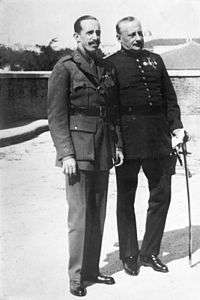
Following World War I, Spain entered the lengthy yet victorious Rif War (1920–1926) to preserve its colonial rule over northern Morocco. Critics of the monarchy thought the war was an unforgivable loss of money and lives, and nicknamed Alfonso el Africano ("the African").[9] Alfonso had not acted as a strict constitutional monarch, and supported the Africanists who wanted to conquer for Spain a new empire in Africa to compensate for the lost empire in the Americas and Asia.[10] The Rif War had starkly polarized Spanish society between the Africanists who wanted to conquer an empire in Africa vs. the abandonistas who wanted to abandon Morocco as not worth the blood and treasure.[11] Alfonso liked to play favourites with his generals, and one of his most favored generals was Manuel Fernández Silvestre.[12] In 1921, when Silvestre advanced up into the Rif mountains of Morocco, Alfonso sent him a telegram whose first line read "Hurrah for real men!", urging Silvestre not to retreat at a time when Silvestre was experiencing major difficulties.[13] Silvestre stayed the course, leading his men into the Battle of Annual, one of Spain's worst defeats. Alfonso, who was on holiday in the south of France at the time, was informed of the "Disaster of the Annual" while he was playing golf. Reportedly, Alfonso's response to the news was to shrug his shoulders and say "Chicken meat is cheap", before resuming his game of golf.[14] Alfonso remained in France and did not return to Spain to comfort the families of the soldiers lost at the "Disaster of the Annual", which many people at the time saw as a callous and cold act, a sign that the King couldn't care less about the lives of his soldiers. In 1922, the Cortes started an investigation into the responsibility for the Annual disaster and soon discovered evidence that the King had been one of the main supporters of Silvestre's advance into the Rif mountains.
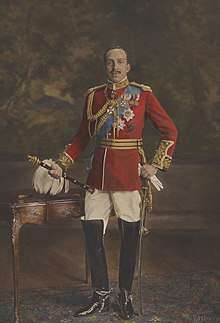
After the "Disaster of the Annual", Spain's war in the Rif went from bad to worse, and as the Spanish were barely hanging onto Morocco, support for the abandonistas grew as many people could see no point to the war.[11] In August 1923, Spanish soldiers embarking for Morocco mutinied, other soldiers in Malaga simply refused to board the ships that were to take them to Morocco, while in Barcelona huge crowds of left-wingers had staged anti-war protests at which Spanish flags were burned while the flag of the Rif Republic was waved about.[11] With the Africanists comprising only a minority, it was clear that it was only a matter of time before the abandonistas forced the Spanish to give up on the Rif, which was part of the reason for the military coup d'état later in 1923.[11] On September 13, 1923, General Miguel Primo de Rivera, seized power in a military coup. He ruled as a dictator with Alfonso's support until 1930. It is believed that one of Alfonso's main reasons for supporting the coup was his desire to suppress the publication of the damning Cortes report into the Annual disaster. The poetic Generation of '27 as well as Catalan and Basque nationalism grew in this era.
Downfall and Second Republic
On 28 January 1930, amid economic problems, general unpopularity and an impending putschist plot led by General Manuel Goded[15] (of which Alfonso XIII was most probably aware),[16] Miguel Primo de Rivera was forced to resign, exiling to Paris (only to die a weeks later of the complication of a diagnosed diabetes in combination with the effects of a flu).[17] Alfonso XIII appointed General Dámaso Berenguer as new Prime Minister, leading to the period known as the dictablanda. The King had so closely associated with the Primo de Rivera dictatorship that it was difficult for him to distance himself from the regime he had supported for almost seven years. The enforced changes relied on the incorrect assumption that Spaniards were going to accept nothing has happened after 1923 and that going back to the prior state of things was possible.[18]
In April 1931, General José Sanjurjo told him even the army was not loyal. On 12 April, the republican parties won a landslide victory in the 1931 municipal elections, perceived as a plebiscite on monarchy. Alfonso left the country on 14 April as the Second Spanish Republic was proclaimed, but did not formally abdicate. He eventually settled in Rome.
By a law of 26 November 1931, Alfonso was accused by the Cortes of high treason.[19] This law would later be repealed by a new law dated 15 December 1938, signed by Francisco Franco.[20]
Exile
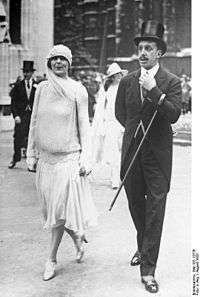
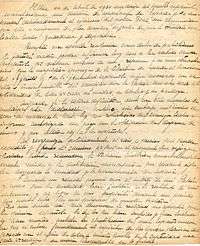
In 1933, his two eldest sons, Alfonso and Jaime, renounced their claims to the defunct throne, and in 1934 his youngest son Gonzalo died. This left his third son Juan, Count of Barcelona his only male heir. Juan later was the father of Juan Carlos I.
Civil War
When the Army rose up against the democratically elected Republican Government [21] and war broke out, Alfonso made it clear he favoured the "Nationalist" military rebels against the Republic. But in September 1936 the Nationalist leader, General Francisco Franco, declared that the Nationalists would not restore Alfonso as king. (The Nationalist army included many Carlist supporters of a rival pretender.) Nevertheless, Alfonso sent his son Juan to Spain in 1936, to participate in the uprising. However, General Mola had Juan arrested near the French border and expelled from the country.
On 29 September 1936, upon the death of Infante Alfonso Carlos, Duke of San Jaime (the Carlist pretender), Alfonso also became the senior heir of Hugh Capet and so was hailed by some French legitimists as King Alphonse I of France and Navarre.
Renunciation of claims to the defunct throne and death
On 15 January 1941, Alfonso XIII renounced his rights to the defunct Spanish throne in favour of Juan. He died in Rome on 28 February of that year.
In Spain, the caudillo Franco ordered three days of national mourning.[22] His funeral was held in Rome in the Church of Santa Maria degli Angeli e dei Martiri. Alfonso was buried in the Church of Santa Maria in Monserrato degli Spagnoli, the Spanish national church in Rome, immediately below the tombs of Popes Callixtus III and Alexander VI.[23] In January 1980 his remains were transferred to El Escorial in Spain.[24]
Legacy
Alfonso was a promoter of tourism in Spain. The need for the lodging of his wedding guests prompted the construction of the luxurious Hotel Palace in Madrid. He also supported the creation of a network of state-run lodges, paradores, in historic buildings of Spain. His fondness for the sport of football led to the patronage of several "Royal" ("Real" in Spanish) football clubs, the first being Real Club Deportivo de La Coruña in 1907.[25] Selected others include Real Madrid, Real Sociedad, Real Betis, Real Unión, Espanyol and Real Zaragoza.
An avenue in the northern Madrid neighbourhood of Chamartín, Avenida de Alfonso XIII, is named after him. A plaza or town center in Iloilo City, Philippines (now Plaza Libertad) was named in his honour called Plaza Alfonso XIII.[26] A street in Merthyr Tydfil, in Wales, was built especially to house Spanish immigrants in the mining industry and named Alphonso Street after Alfonso XIII.[27]
Alfonso XIII appears as "King Buby" in Luis Coloma's story of Ratoncito Pérez (1894), which was written for the King when he was 8 years old. The story of Ratoncito Pérez has been adapted into further literary works and movies since then, with the character of Alfonso XIII appearing in some. Alfonso XIII is also mentioned on the plaque to Ratoncito Pérez on the second floor of "la calle del Arenal".
Marriage and legitimate children

On 31 May 1906, Alfonso married British-born Princess Victoria Eugenie of Battenberg (1887–1969). Only entitled to the style of Serene Highness by birth, Ena, as she was known, was granted the higher honorific of Royal Highness one month before her wedding.
Alfonso and Ena had six children: Alfonso, Prince of Asturias (1907–1938); Infante Jaime, Duke of Segovia (1908–1975); Infanta Beatriz (1909–2002), Infante Fernando (stillborn); Infanta María Cristina (1911–1996); Infante Juan, Count of Barcelona (1913–1993) and Infante Gonzalo (1914–1934).
Illegitimate issue
Alfonso also had six known illegitimate children:
By French aristocrat Mélanie de Gaufridy de Dortan, married to Philippe de Vilmorin, he had Roger Marie Vincent Philippe Lévêque de Vilmorin (1905–1980);[28][29] by Pauline of Saint Glen, he had Charles Maxime Victor of Saint Glen (1914–1934); by Béatrice Noon, he had Juana Alfonsa Milán y Quiñones de León (1916–2005); by Spanish actress María del Carmen Ruiz y Moragas he had Ana María Teresa Ruiz y Moragas (1925–1965) and Leandro Alfonso Luis Ruiz y Moragas (1929–2016); and, by Marie Sousa he had Alonso of Borbon Sousa (1930–1934).
Arms
- Heraldry of Alfonso XIII of Spain
_Version_with_Golden_Fleece_and_Order_of_Charles_III_Collars.svg.png)
_Version_with_Golden_Fleece_and_Charles_III_Orders.svg.png)
.svg.png) Coat of arms of Alfonso XIII with royal supporters
Coat of arms of Alfonso XIII with royal supporters
(1931)[33]
Honours
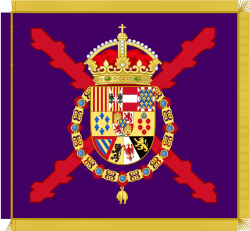
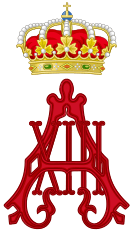
Spanish honours
- 1,072nd Knight of the Order of the Golden Fleece, 1886[34]
- Grand Cross with Collar of the Order of Charles III, 1886[35][36]
- Grand Cross with Collar of the Order of Isabella the Catholic, 1927[37]
- Order of Santiago[38]
- Order of Calatrava[39]
- Order of Alcántara[40]
- Order of Montesa[41]
- Maestranza de caballería (Royal Cavalry Armory) de Ronda, Sevilla, Granada, Valencia y Zaragoza
Foreign honours
.svg.png)
.svg.png)

.svg.png)
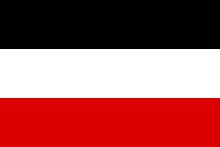
_crowned.svg.png)
.svg.png)
.svg.png)
.svg.png)
.svg.png)


.svg.png)
.svg.png)

- Honorary Grand Cross of the Royal Victorian Order, 28 July 1897[54]
- 815th Knight of the Order of the Garter, 16 May 1902 – King Edward VII's brother, the Duke of Connaught attended the festivities marking the King's enthronement, and invested him as a Knight in a special ceremony.[50][55]
- Royal Victorian Chain, 9 June 1905[56]
In the Royal Library of Madrid, there are many books with different emblems and super libros of the king.[57]
Ancestry
| Ancestors of Alfonso XIII of Spain | |||||||||||||||||||||||||||||||||||||||||||||||||||||||||||||||||||||||||||||||||||||||||||||||||||||||||||||||||||||||||||||||||||||||||||||||||||||||||||||||||||||||||||||||||||||||||||||||||||||||||||||||||||||||||||||||||||||||||||||||||||||||||||||||||||||||||||||||||||||||||
|---|---|---|---|---|---|---|---|---|---|---|---|---|---|---|---|---|---|---|---|---|---|---|---|---|---|---|---|---|---|---|---|---|---|---|---|---|---|---|---|---|---|---|---|---|---|---|---|---|---|---|---|---|---|---|---|---|---|---|---|---|---|---|---|---|---|---|---|---|---|---|---|---|---|---|---|---|---|---|---|---|---|---|---|---|---|---|---|---|---|---|---|---|---|---|---|---|---|---|---|---|---|---|---|---|---|---|---|---|---|---|---|---|---|---|---|---|---|---|---|---|---|---|---|---|---|---|---|---|---|---|---|---|---|---|---|---|---|---|---|---|---|---|---|---|---|---|---|---|---|---|---|---|---|---|---|---|---|---|---|---|---|---|---|---|---|---|---|---|---|---|---|---|---|---|---|---|---|---|---|---|---|---|---|---|---|---|---|---|---|---|---|---|---|---|---|---|---|---|---|---|---|---|---|---|---|---|---|---|---|---|---|---|---|---|---|---|---|---|---|---|---|---|---|---|---|---|---|---|---|---|---|---|---|---|---|---|---|---|---|---|---|---|---|---|---|---|---|---|---|---|---|---|---|---|---|---|---|---|---|---|---|---|---|---|---|---|---|---|---|---|---|---|---|---|---|---|---|---|---|---|---|
| |||||||||||||||||||||||||||||||||||||||||||||||||||||||||||||||||||||||||||||||||||||||||||||||||||||||||||||||||||||||||||||||||||||||||||||||||||||||||||||||||||||||||||||||||||||||||||||||||||||||||||||||||||||||||||||||||||||||||||||||||||||||||||||||||||||||||||||||||||||||||
See also
- 1902 Copa de la Coronación
References
- Magnificent Monarchs (Fact Attack series) p.21 by Ian Locke; published by Macmillan in 1999; ISBN 978-0330-374965
- "The Happiest Living Monarch", New York Times. 14 August 1889.
- "Alfonso's Reign Begins on 17 May; He Will Take the Oath on That Day – Festivities to Last a Week," New York Times, 29 March 1902.
- "Royal Wedding #1: Princess Victoria Eugenie of Battenberg & King Alfonso XIII of Spain". Edwardian Promenade. Retrieved 25 June 2015.
- "Reinas Borbones de cuidado". elmundo.es. Retrieved 25 June 2015.
- his wife was British, his mother Austrian, amongst other family relationships.
- ""Royal Knight of Charity": King Alfonso XIII of Spain in WWI". loc.gov. Retrieved 19 January 2018.
- Barry 171.
- "Rebelion. Prlogo para "Alfonso XIII: un enemigo del pueblo" de Pedro L. Angosto". rebelion.org. Retrieved 25 June 2015.
- Perry, James Arrogant Armies Great Military Disasters and the Generals Behind Them, Edison: Castle Books, 2005 page 274
- Perry, James Arrogant Armies Great Military Disasters and the Generals Behind Them, Edison: Castle Books, 2005 page 286.
- Perry, James Arrogant Armies Great Military Disasters and the Generals Behind Them, Edison: Castle Books, 2005 page 276
- Perry, James Arrogant Armies Great Military Disasters and the Generals Behind Them, Edison: Castle Books, 2005 page 280.
- Perry, James Arrogant Armies Great Military Disasters and the Generals Behind Them, Edison: Castle Books, 2005 page 284.
- Casals 2004, p. 211.
- Tuñón de Lara 2000, p. 225.
- Casals 2004, p. 214–216.
- Avilés Farré, Elizalde Pérez-Grueso & Sueiro Seoane 2002, p. 308.
- See: Ley aprobando el acta acusatoria contra D. Alfonso de Borbón Habsurgo-Lorena, dictando sentencia condenatoria en la forma que se inserta. Gaceta de Madrid no. 332, 28/11/1931, p. 1250
- See: Ley concediendo la nacionalidad española a D. Alfonso de Borbón. Boletín Oficial del Estado no. 173, 20/12/1938, p. 3039.
- Paul Preston, History of the Spanish Civil War
- "Mourning in Spain", The Times (3 March 1941): 3.
- "Italians to Mourn Death of Alfonso," The New York Times. 2 March 1931.
- "21 Guns for Dead King's Homecoming", The Times (21 January 1980): 4.
- "Deportivo history – Football Espana". football-espana.net. Retrieved 25 June 2015.
- "Plaza Libertad: The face of Ilonggo History". Iloilo I LOVE!. Retrieved 25 June 2015.
- Morris, Jan (1986). The Matter of Wales (1986 ed.). Penguin Books. p. 339. ISBN 0-14-008263-8.
- (in French) XII. Roger de Vilmorin, sur Dynastie capétienne, consulté le 09/09/2013
- (in French) Jean-Fred Tourtchine (préf. Juan Balansó), Les manuscrits du C.E.D.R.E. – dictionnaire historique et généalogique, numéro 6 : Le royaume d'Espagne, vol. 3, Cercle d'Études des Dynasties Royales Européennes, Paris, 1996, 213 p. ISSN 0993-3964
- Faustino Menéndez Pidal de Navascués; María del Carmen Iglesias (1999). Símbolos de España. ISBN 978-84-259-1074-6.
- Dotor, Santiag. "Discussion on the 1931 addition of Jerusalem arms". Royal Banner of Spain (1761–1931). Flags of the World. Retrieved 19 March 2013.
- Eduardo García-Menacho y Osset (2010). Introducción a la Heráldica y Manual de Heráldica Militar Española. Ministerio de Defensa. Subdir. Gral. Publicaciones. pp. 105–107. ISBN 978-84-9781-559-8.
- Ricardo Mateos Sáinz de Medrano (2007). La reina María Cristina: madre de Alfonso XIII y regente de España. ISBN 978-84-9734-638-2.
- Collier, William Miller. (1912). At the Court of His Catholic Majesty, pp. 35–36; Order of the Golden Fleece.
- "Real y distinguida orden de Carlos III". Guía Oficial de España (in Spanish). 1929. p. 218. Retrieved 21 March 2019.
- Miller, pp. 37–38; Orden de Carlos III (in Spanish) Archived 24 August 2007 at the Wayback Machine.
- "Real Orden de Isabel la Católica". Guía Oficial de España (in Spanish). 1929. p. 237. Retrieved 21 March 2019.
- Miller, pp. 39–39; Order of Santiago Archived 28 January 2008 at the Wayback Machine.
- Miller, pp. 39–39; Order of Calatrava Archived 10 February 2008 at the Wayback Machine.
- Miller, pp. 39–39; Order of Alcántara Archived 13 February 2008 at the Wayback Machine.
- Miller, pp. 39–39; Order of Montesa Archived 13 February 2008 at the Wayback Machine.
- "A Szent István Rend tagjai" Archived 22 December 2010 at the Wayback Machine
- Royal Decree of 14 February 1902
- Justus Perthes, Almanach de Gotha (1922) page 36
- Jørgen Pedersen (2009). Riddere af Elefantordenen, 1559–2009 (in Danish). Syddansk Universitetsforlag. p. 470. ISBN 978-87-7674-434-2.
- M. Wattel, B. Wattel. (2009). Les Grand'Croix de la Légion d'honneur de 1805 à nos jours. Titulaires français et étrangers. Paris: Archives & Culture. p. 451. ISBN 978-2-35077-135-9.
- Hof- und Staats-Handbuch des Königreichs Bayern (1906), "Königliche-Orden" p. 8
- Hof- und Staats-Handbuch des Königreich Württemberg (1907), "Königliche Orden" p. 29
- "Japan to Decorate King Alfonso Today; Emperor's Brother Nears Madrid With Collar of the Chrysanthemum for Spanish King," New York Times, 3 November 1930; see also Nutail, Zelia. (1906). The Earliest Historical Relations Between Mexico and Japan, p. 2.
- "The King of Spain´s enthronement". The Times (36770). London. 17 May 1902. p. 7.
- "Grand Crosses of the Order of the Tower and Sword". geneall.net. Retrieved 2018-09-22.
- "Ordinul Carol I" [Order of Carol I]. Familia Regală a României (in Romanian). Bucharest. Retrieved 17 October 2019.
- Royal Thai Government Gazette (4 June 1899). "พระราชทานเครื่องราชอิสริยาภรณ์ที่ประเทศยุโรป (ต่อแผ่นที่ ๙ หน้า ๑๓๐)" (PDF) (in Thai). Retrieved 8 May 2019. Cite journal requires
|journal=(help) - Shaw, Wm. A. (1906) The Knights of England, I, London, p. 423
- "No. 27441". The London Gazette. 10 June 1902. p. 3749.
- "No. 27803". The London Gazette. 9 June 1905. p. 4107.
- "Real Biblioteca – Búsqueda por ex libris". realbiblioteca.es. Retrieved 25 June 2015.
Bibliography
- Avilés Farré, Juan; Elizalde Pérez-Grueso, María Dolores; Sueiro Seoane, Susana (2002). Historia política de España, 1875-1939. 1. Tres Cantos: Ediciones Istmo. ISBN 84-7090-320-9.CS1 maint: ref=harv (link)
- Barry, John M. (2004). The Great Influenza: The Epic Story of the Greatest Plague in History. Viking Penguin. ISBN 0-670-89473-7.
- Casals, Xavier (2004). "Miguel Primo de Rivera, el espejo de Franco". Miguel Primo de Rivera y Orbaneja. Madrid: Ediciones B. pp. 123–253. ISBN 84-666-1447-8.CS1 maint: ref=harv (link)
- Churchill, Sir Winston. Great Contemporaries. London: T. Butterworth, 1937. Contains the most famous single account of Alfonso in the English language. The author, writing shortly after the Spanish Civil War began, retained considerable fondness for the ex-sovereign.
- Collier, William Miller. At the Court of His Catholic Majesty. Chicago: McClurg, 1912. The author was American ambassador to Spain from 1905 to 1909.
- Noel, Gerard. Ena: Spain's English Queen. London: Constable, 1984. Considerably more candid than Petrie about Alfonso, the private man, and about the miseries the royal family experienced because of their haemophiliac children.
- Nuttall, Zelia (1906). The earliest historical relations between Mexico and Japan: from original documents preserved in Spain and Japan. The University Press.
- Petrie, Sir Charles. King Alfonso XIII and His Age. London: Chapman & Hall, 1963. Written as it was during Queen Ena's lifetime, this book necessarily omits the King's extramarital affairs; but it remains a useful biography, not least because the author knew Alfonso quite well, interviewed him at considerable length, and relates him to the wider Spanish intellectual culture of his time.
- Pilapil, Vicente R. Alfonso XIII. Twayne's rulers and statesmen of the world series 12. New York: Twayne, 1969.
- Sencourt, Robert. King Alfonso: A Biography. London: Faber, 1942.
- Tuñón de Lara, Manuel (2000) [1967]. La España del siglo XX. Vol. 1. La quiebra de una forma de Estado (1898-1931). Tres Cantos: Ediciones Akal. ISBN 84-460-1491-2.
External links
| Wikimedia Commons has media related to Alfonso XIII of Spain. |
- Historiaantiqua. Alfonso XIII; (in Spanish) (2008)
- Visit by Alphonso XIII to Deauville in 1922 (with images)
- Newspaper clippings about Alfonso XIII of Spain in the 20th Century Press Archives of the ZBW
Alfonso XIII of Spain Born: 17 May 1886 Died: 28 February 1941 | ||
| Regnal titles | ||
|---|---|---|
| Vacant Title last held by Alfonso XII |
King of Spain 17 May 1886 – 14 April 1931 |
Vacant Title next held by Juan Carlos |
| Titles in pretence | ||
| Loss of title | — TITULAR — King of Spain 14 April 1931 – 15 January 1941 |
Succeeded by Juan III |
| Preceded by Alfonso Carlos |
— TITULAR — King of France and Navarre 29 September 1936 – 28 February 1941 Reason for succession failure: Bourbon monarchy deposed in 1830 |
Succeeded by Jaime IV |
| Awards and achievements | ||
| Preceded by Dwight F. Davis |
Cover of Time Magazine 22 December 1924 |
Succeeded by Charles Evans Hughes |
